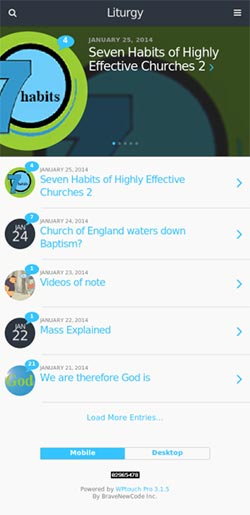
Occasionally I glance at statistics of this site, and recently I spotted a change in the default way that google presents statistics. It now first gives what sort of devices are being used.
I was fascinated that about half of people viewing this site are doing so using a mobile, tablet, or iPad. So I went back to look at a year ago. Then it was about a quarter.
Statistics like this, for the internet generally, are unclear – but what is clear is that the use of mobile access to the web, and tablets and iPads, is increasing. Rapidly.
I have long had this site able to be viewed on mobiles in a simplified manner. And my intention is to improve navigation for tablets, iPads, etc. by, for example, removing drop-down menus and organising that hierarchy differently. This is called having responsive web design – trying to to “provide an optimal viewing experience – easy reading and navigation with a minimum of resizing, panning, and scrolling — across a wide range of devices (from mobile phones to desktop computer monitors)”.
If your website, your church website, diocesan website, etc. is not using responsive web design, you are stuck in a last-millennium paradigm. If your site is not being accessed by people using mobiles, tablets, and iPads, then you have a serious issue with the demographic that your site is limited to.
I have been advocating using WordPress as the foundation for your site for over five years. It is simple and free. This site uses Headway, a drag and drop WordPress theme and I find that very flexible. To make the site mobile-friendly merely requires using WPTouch, a WordPress plugin.
You can check what a site looks like on a mobile on this mobile emulator.



Are 50% of hits to your site coming through mobile, or 50% of unique visitors? And in either case, what would interest me more is to know what percentage of your visitors access the site through mobile only. If that was a small percentage, then people might have an excuse for not creating a mobile-friendly site–if it were hard to do so 🙂
I’m trying to think of the name of a company I know of that focuses purely on church web sites. It’s completely slipping my mind.
Hi Matt. I don’t have time to check the fine details now. From memory, I thought about a quarter are using mobile, and about a quarter iPads and tablets. One of my points was that having one’s site responsive is only a plugin away for mobile. Removing drop-down menus, that’s more work and thinking things through. Blessings.
Sorry for confusion; that’s my fault – since in the US we use “cell phone” rather than “mobile” I tend to use “mobile” to mean “anything but a desktop computer”. And that last bit was meant to be sarcastic, or at least ironic. The point that it seemed you wanted to make was that there should be a mobile-friendly version of a site, otherwise the site owner is missing a potentially large audience. I agree in principle, but just meant to point out that the audience is only missing the content if they never, or rarely, access the site through a desktop computer. (For my own part, I nearly always see the mobile version of the site, because my wife loves playing games on our desktop 😀 so having this version of the site is very important to me; I’m glad you believe that it is as well.)
Thanks, Matt. And it’s cool to have a mobile user identify himself in a comment. Blessings.
There are changes coming up to top-level domain names this year, which will allow you to choose from a wide range of ways to label your website. So you will not longer need to end your domain with .nz or .com.
Here is the list sent out by our ISP:
http://www.1stdomains.co.nz/new_gtlds/search.php
So far I have found .church, .bible and .christmas. There may be others.
Thanks, David. It will be interesting to see how much they cost, and if it is first in first served. Blessings.
For the ones released so far, it is the same pricing as other domain names. But that will depend on the plans that your ISP offers. You should be able to get one for a reasonable small annual rental if you shop around. (I am not going to promote providers here, so readers can do their own research on that).
And it is first in, first served. So if it is a name you think someone else will take, then get in quick and take it. You can always just keep it parked for a while.
But usual word of caution. Doing this does need to be part of a larger web and communications strategy. Just adding a new domain name to an average church website isn’t going to attract more visitor (virtual or real) and is probably a waste of offertory money.